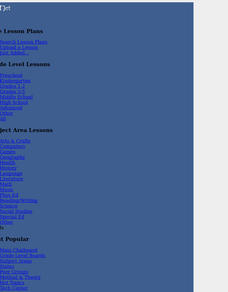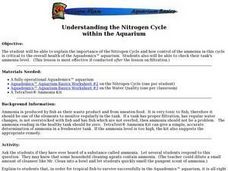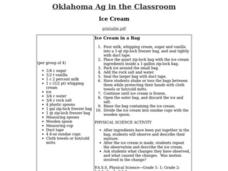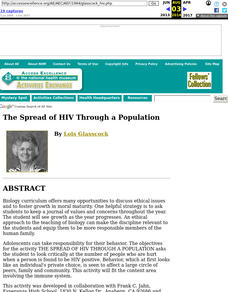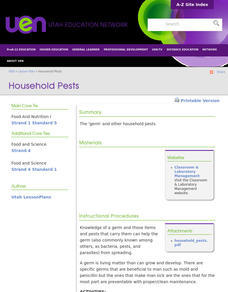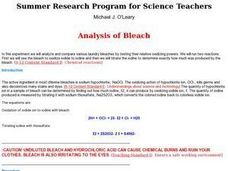Curated OER
Pollution
First graders identify and discuss different kinds and sources of of pollution. They explain why it is important to keep the environment free of pollution. They make a poster depicting the dangers of pollution and make litter boxes.
Curated OER
Plum Stone Dice Game
Young scholars read about a Native American dice game online. They make replica games, and practice playing with them. They predict the outcome of the dice rolls by completing a dice throw chart.
Curated OER
Is Environmental Health a Basic Human Right?
High schoolers examine basic human rights as defined by the United Nations. They develop a list of rights by class consensus, read an article, answer discussion questions, and complete a worksheet.
Curated OER
Understanding the Nitrogen Cycle within the Aquarium
Young scholars discuss ammonia, and ways it may get into the aquarium. They complete a worksheet about the Nitrogen Cycle. Students learn how to get the ammonia and nitrite out of their aquarium.
Curated OER
Habitats and Adaptations
Students research and describe the habitat and adaptations of a reef animal. After the student is assigned a habitat, they design and draw a cresture adapted to eat each food and to live in each habitat.
Curated OER
I Won't Live in a Toxic World
Students examine four separate environmental health issues using fish-bowl technique, and discuss roles of both government and citizens in maintaining a pollution-free environment.
Curated OER
Brothers Grimm
Class members participate in a read aloud of an illustrated version of fairy tales by the Brothers Grimm. They discuss the tale,"A Fisherman and His Wife" to discover how fairy tales can help us think about our own situations. They also...
Curated OER
Unsaturated, Saturated and Supersaturated
High schoolers investigate unsaturated, saturated and supersaturated solutions. In this solutions lesson plan, students experiment with sodium acetate and produce three different types of solutions including a saturated solution of...
Curated OER
Microscope Basics
In this microscope learning exercise, students label the parts of a microscope, they calculate the powers of magnification for each lens on the scope and they answer questions about making a wet mount slide.
Curated OER
An Introduction to Acids and Bases
Students explore acids and bases. In this instructional activity about acids and bases, students do an experiment to test certain items to determine what they are. Students use cabbage and litmus paper as indicators. Students understand...
Curated OER
Earth Day Crossword Puzzle
In this crossword puzzle about Earth Day worksheet, students read the descriptive sentences, use the word bank, and complete the puzzle. Students write 12 words.
Curated OER
Volumetric Analysis 3-To Determine the Relative Molecular Mass of a Soluble Base
In this volumetric analysis instructional activity, students determine the relative molecular mass of an unknown group 1 carbonate by experimenting with a known amount of hydrochloric acid. Students use volumetric analysis to determine...
Curated OER
How to Use the Burette
In this burette worksheet, students learn how to properly use a burette to perform a titration and they run 4 trials and indicate their data. Students find the initial volume, the final volume, the titre volume and the mean titre volume...
Curated OER
The Burette
In this burette use worksheet, students are given directions for performing a titration using a burette. Students practice reaching the end-point oftitrations and they calculate the mean volume of three trials.
Curated OER
Cherokee Leaf Printing
Young scholars investigate their local creeks and forests and practice identifying trees. For this ecology identification lesson, students utilize a pad and pencil while on a field trip near their school and describe their trip while...
Curated OER
Ice Cream
Students create ice cream in a bag and snow ice cream to study the effects of freezing on foods. In this ice cream lesson, students understand the effects of freezing on cells.
Curated OER
Introduction to the Scientific Method
Learners recognize and follow the steps of the scientific method to complete an experiment. In this scientific method lesson, students use inquiry tools to measure objects. Learners record their data.
Curated OER
The Gulf Oil Spill Provides Many Learning Opportunities
You can use math and engineering lesson plans to delve into the affects of the recent oil spill.
Curated OER
The Spread of HIV Through a Population
Young scholars use a model to illustrate the spread of HIV through an adolescent population and, acting in the role of epidemiologists, explore the dilemmas of HIV infection presented by the simulation. beneficence and justice.
Curated OER
Household Pests
Identify methods that prevent food-borne illnesses and contamination. National Standard 14.4.1 Identify food-borne illness Identify types of food-borne illness and their symptoms: botulism, e-coli, hepatitis, salmonella, staphylococci...
Curated OER
ENGINEERING TOOTHPASTE
Students make a class list of household products and discuss how many of these products are made through chemistry. They guess the ingredients in the products and imagine how toothpaste might be made. They make toothpaste.
Curated OER
Global Resources: What Will You Do with Your Power?
Learners examine the human impact on natural resources. They read and discuss an article, evaluate nations regarding their environmental problem-solving, develop a presidential speech on the environment, and conduct a natural resources...
Curated OER
Living in Hurricane Country
Students examine how hurricanes grow and their strength levels through an interactive program. They define terms associated with hurricanes and how the public is affected by the storms.
Curated OER
Analysis of Bleach
Students analyze and compare laundry bleaches by testing their oxidizing powers. They conduct their lab experiment, compare/contrast their results with other students' work, and complete a worksheet.


